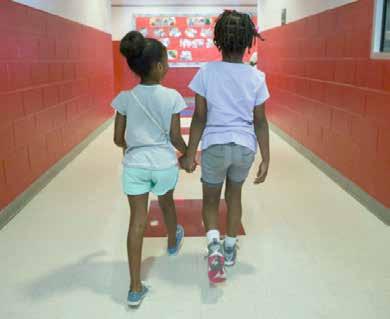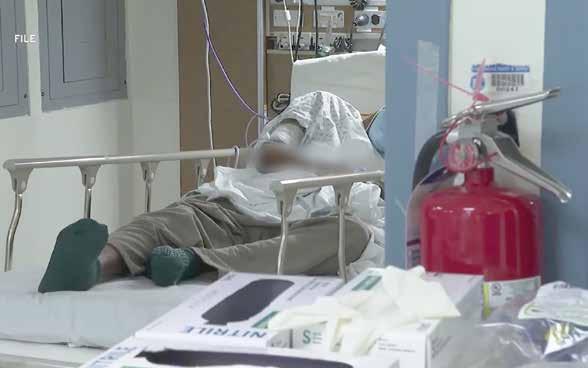
21 minute read
International
PETWORTH PRINTING
Your Quality Printers
301 Kennedy Street, NW n Washington, DC 202-291-6565
PRINTING & DESIGN Color / Black & White Printing
n Booklets
n Brochures
n Business Cards
n Banners n Canvas Bags
n Color Copies
n Contracts & Vouchers
n Church Fans
n Fax & Scan
n Programs
n Postcards
n Promotional Products
n Posters & Signs n Tithe Envelopes
n Tickets & Flyers
n T-Shirts
n Mugs & Glassware
n Notary
10% OFF BOOKLETS AND T-SHIRTS
*NEW CUSTOMERS ONLY*
SEE OUR ONLINE STORE: www.QualityPrintersDC.com
Traditional Help Buttons
At Home In the Car On a Walk On Vacation At the Park Shopping
A Help Button Should Go Where You Go!
To be truly independent your personal emergency device needs to work on the go.
Service availability and access/coverage on the AT&T network is not available everywhere and at all times. Current GPS location may not always be available in every situation. Order Now & Receive a FREE Lockbox! 1-800-681-0667
View Sports Photos by John De Freitas at:
africa now
COMPILED BY OSWALD T. BROWN
Ethiopia Plans to Close Eritrean Refugee Camp Despite Concerns
Ethiopia is stepping up preparations to go ahead with a planned closure of a camp for Eritrean refugees, despite concerns among residents and calls by aid agencies to halt their relocation over coronavirus fears.
Home to some 26,000 people, including some 1,600 minors, Hitsats is one of four camps in the northern Tigray region hosting nearly 100,000 Eritrean refugees, according to the United Nations refugee agency (UNHCR).
Earlier this month, Ethiopia’s Agency for Refugee and Returnee Affairs (ARRA) announced to residents in Hitsats camp that the federal government had decided to relocate them to Mai Aini and Adi Harush camps, or offer them the possibility to live in towns.
The plan has yet to be executed amid the coronavirus pandemic, but officials say preparations continue, Al Jazeera reported.
“We are ready to start the relocation at any time,” Eyob Awoke, deputy director general of ARRA, told Al Jazeera, noting that the declaration of a state of emergency last week due to the pandemic had forced authorities “to timely adapt the initial plan.”
“External factors are hampering us but we can start with small numbers,” Eyob said, Al Jazeera reported. “Hitsats refugees are suffering a lot from shortage of water, shelter and access to electricity. Merging of these camps is mainly required to ensure efficient and effective use of available resources.” WI
caribbean now

CARICOM Chairman Praised for ‘Outstanding Leadership’ in COVID-19 Battle
Dr. Tedros Adhanom Ghebreyesus, director-general of the World Health Organization (WHO), on Friday praised the Barbados Prime Minister Mia Mottley, chairman of the Caribbean Community (CARICOM), for outstanding leadership during the ongoing coronavirus threat.
On Wednesday, April 15, Mottley conducted a Special Emergency Meeting of CARICOM Heads of Government via a video conference, during which they agree agreed on a way forward in the community’s battle against the COVID-19 pandemic.
In a press release following the meeting, the CARICOM Heads of Government noted that they “were of the view that it was regrettable that resources for [WHO] were being threatened at a time when all must join in leading the fight against the pandemic.”
This was clearly in response to U.S. President Donald Trump’s decision to suspend funding to WHO while his administration reviews what he described as WHO’s “disastrous” role in “covering up” the outbreak of the coronavirus in China.
The CARICOM press release noted that the leaders received “presentations from the Caribbean Public Health Agency (CARPHA), the University of the West Indies (UWI), the Caribbean Development Bank (CDB) and Archbishop Jason Gordon.” WI

Stay Informed! www.washingtoninformer.com
LIFESTYLE
A CONTINUING SERIES Strategies to Survive,
Sustain and Succeed UPDATE COVID 19 COVID 19
HOW TO TALK TO CHILDREN ABOUT THE CORONAVIRUS HEALTH CRISIS
Howard University Professor Tyish S. Hall Brown, Ph.D., MHS, is a child and adolescent psychologist and director of the SchoolBased Behavioral Health Program in the Howard University College of Medicine. In conjunction with #BisonIntheKnow, Dr. Hall Brown recently completed a short video offering tips on how to talk to young people during the COVID-19 health crisis. Watch the video here.
She notes that children are vulnerable to symptoms of anxiety and depression as a result of exposure to the COVID-19 health crisis. Her tips include a recommendation to, “talk to them often, ask them what they know about social distancing and hygiene protocols, encourage them to take their remote learning seriously and spend quality time indoors having fun.”
In the #BisonIntheKnow video, she says, “While we know that exercise, nutrition and sleep are important to child development, building skills to prevent or deal with symptoms of anxiety and depression that they may face can be invaluable.” One activity that she recommends is called “Five Senses” – an activity often used to combat anxiety, particularly at night.
Her instructions are as follows: We start by taking a deep breath. Inhale for a count of three and then exhale for a count of three. Now look around you and say aloud five things that you see. Next say out loud four things you can feel right now. Then, pause for a moment and listen to what is happening around you. Say three of the sounds that you hear out loud. Next, say out loud two things you can smell right now. If you can, move around

to find things to smell. If you can’t move around, say out loud your two favorite smells. Finally, say out loud one thing you can taste right now. Now, take another deep breath. Inhale for a count of three and then exhale for a count of three.
Thanks Doc!
TOUCHING YOUR FACE MAY BE GOOD FOR GLAMOUR BUT NOT YOUR HEALTH
In an informative feature published recently in The Hill and penned by Greg Hudson, the local news reporter poses the following: How often do you touch your face and does that increase your risk for the coronavirus?
As Hudson seeks answers to his question, he says that several studies indicate that while we touch our faces far more often that we may realize or should, that health officials continue to recommend that we put a halt to this habit – particularly in light of the continuing COVID-19 pandemic.
So, while we may be following the advice of health experts so way wash your hands, wash your hands and wash your hands again to avoid the coronavirus, such diligence may be for naught if you’re still touching your face a lot.
What’s more, because the virus can live nine hours or more on hard surfaces, it’s fairly easy to make contact with COVID-19 simply by touching just about anything in the public space. And because we touch or face with much greater frequency than we wash our hands, we are putting ourselves at significant risk of infection, probably without even realizing it.
Here’s what our insightful fellow journalist shared.
One study published by the Journal of Occupational and Environmental Hygiene recorded 10 subjects as they did office-style work for three hours in a room by themselves. On average, they touched their faces 15.7 times per hour. A similar study of 26 students in South Wales showed they averaged 23 touches per hour, with almost half of those involving contact between the hand and mucous from the nose, eyes and mouth. A slightly larger study of 250 individuals in public places in the U.S. and Brazil came with a lower average of 3.6 times per hour, perhaps because people are less likely to touch their faces in public. But the same study showed they touched common objects or surfaces 3.3 times per hour — the type of public surfaces that could be touched by coronavirus sufferers as well.
In the eerily prescient movie “Contagion,” a doctor laments, “The average person touches their face 2,000 to 3,000 times a day, 3-5 times a minute.” There’s no footnote as to where the screenwriter got that particular statistic, but it certainly resonates with many people who admit they touch their faces pretty much all of the time. alone 23 times an hour). So, what does this mean for our health and safety against a possible epidemic? So, what’s a person to do? We touch our faces almost by instinct – sometimes to rub our eyes that may have gotten a bit dry or to scratch a spot that’s started to itch. Other times, we touch our faces to get hair out of our eyes, to smooth in a bit of lotion or to ponder while resting our chin on our outstretched palm.
Maybe the best thing to do, since we probably won’t be successful in totaling ending a habit that’s part of our incessant routine for most of our lives, is to keep our hands “busy and occupied.”
Pick up a book, work on your tablet, begin to crochet that blanket or shawl that you’ve been promising yourself you’d get to “one of these days.”
Good Luck! WI

TOO MUCH MONEY IS LOST TO HEALTH CARE FRAUD. Treat your health care dollars like real money! Because it is real money!
REPORT HEALTH CARE FRAUD! If you have or someone you know has... • Been double billed (billed twice) • Been billed for products or services not received • Been offered free services • Had personal information misused
Call 202-434-2099 (All calls are confidential.) or email LCESMP@aarp.org
This project was supported, in part by grant number 90MPPG0042 from the U.S. Administration for Community Living, Department of Health and Human Services, Washington, D.C. 20201.
LIFESTYLE Smithsonian’s Anacostia Community Museum: It’s Our River: A Decade of Urban Waterways
By Katrina D. Lashley, Program Coordinator, Urban Waterways Project, Smithsonian’s Anacostia Community Museum
April 22nd marks the 50th anniversary of Earth Day. It’s an annual event first conceived as a moment to honor the earth and promote peace that eventually transformed into a teach-in aimed at addressing environmental challenges through participatory community action. This significant anniversary takes place in a remarkable moment in which the global community finds itself in the midst of the uncertainties, disruptions, and stress of the COVID-19 pandemic. The 50th anniversary of Earth Day also takes place in an era of growing tensions and calls for action in the face of the undeniable impacts of climate change, particularly on communities who bear the least responsibility and the most burden.
In 2010, against the backdrop of ongoing discussions around the restoration and redevelopment of the Anacostia River, the Anacostia Community Museum’s late senior historian Dr. Gail S. Lowe decided to more thoroughly explore this body of water. The Anacostia River not only lends its name to the surrounding area but has shaped life along its banks for thousands of years and has been, for many, a psychological and physical barrier. In the narratives of East of the River’s isolation, the Anacostia River is often mentioned as the cause, but few have explored the history and the life of the river itself. How had the Anacostia become “The Forgotten River?” What had this invisibility meant for the communities, the people living along its banks? What were the human, psychological, social, economic, and political costs of such invisibility?
The resulting exhibition, Reclaiming the Edge: Urban Waterways & Civic Engagement, opened in 2012. Since then, the Anacostia Community Museum has continued with community-based research, programming, and community-building efforts, including workshops, community forums, a national symposium, summer programming and a project newsletter. The Urban Gardening program (now in its 8th year) connects participants to the existence and accessibility of the natural world in their community. In its third year, the Women’s Environmental Leadership initiative (WEL) builds the capacity for future environmental leadership by convening a national and international network of established women environmental leaders with emerging and aspiring leaders for in-person discussions focused on the exchange of best practices, wisdom, and experience. Through annual summits, associated programming, and oral histories, WEL addresses mentorship, educational and career opportunities, as well as leadership models. The launch of the Urban Waterways website occurring later this spring and the summer publication of the first volume of Women, Environmentalism & Justice (an illustrated publication highlighting the impacts of women in the environmental movement) serve as the next steps in the project’s ongoing effort to provide a platform for community leadership and expertise, in its many forms.
A decade of Urban Waterways documentation and programming dispels the commonplace narratives that urban communities are separate from and uninterested in the natural world. By evidence of their personal and professional experiences, our community partners help to push back against narrow definitions of environment and environmentalism. By framing their understanding of the environment through the lenses of justice, equity, civil rights, sense of place, culture and identity, collaborators provide pathways to action. These actions serve as reminders that, in times of uncertainty, communities can turn to a history of active citizen participation providing blueprints for possible ways forward. In the face of seemingly insurmountable pressures on a global scale, communities continue to do the work. WI

5 The Anacostia Community Museum’s Museum Academy Program explores the Washington Channel and the Anacostia River aboard the Chesapeake Bay Foundation boat, The Susquehanna, 2014. (Photograph by Susana Raab, Anacostia Community Museum Archives, Smithsonian Institution)
Remarkable Story of Final Transatlantic Slave Survivor Reveals She Died in 1940
By Stacy M. Brown WI Senior Writer @StacyBrownMedia
This is part of an ongoing Washington Informer series about the Women’s Suffrage Movement and an initiative that includes Informer Publisher Denise Rolark Barnes that will use the lens of history, the fabric of art and culture and the venue of the public square to shine a light into dark places, equipping all with a compass to chart the way forward. The initiative lives in the institutional home of the Washington Informer Charities.
At 2 years old, Matilda McCrear was kidnapped in 1860 by slave traders in West Africa. Along with her parents and three siblings, Matilda was forced to make the long and dangerous trip across the Atlantic Ocean on the bottom of a slave ship.
Matilda and her family were transported on the Clotilda, the last ship to carry enslaved Africans to America. The boat docked in Mobile, Alabama, in July 1860, and Matilda was purchased by Memorable Walker Creagh, an Alabama slave owner.
Hannah Durkin, a researcher at Newcastle University in England, has discovered that Matilda, who died in 1940 at the age of 81 or 82, was the last African-born slave to die.
Post-slavery, Matilda became a staunch women’s and human rights advocate including pushing for women’s suffrage, historians noted.
Remarkably, Matilda’s grandson only recently learned about his family’s history based on Durkin’s research and the online journal Slavery and Abolition.
“I had no idea she’d been on the Clotilda,” Johnny Crear, Matilda’s 83-year-old grandson, said in a news release. “It came as a real surprise. Her story gives me mixed emotions because if she hadn’t been brought here, I wouldn’t be here. But it’s hard to read about what she experienced.”
Matilda’s family was split up immediately when two of her brothers were left in West Africa. She would never know what happened to them, according to Durkin. On arrival in America, Matilda was bought by Creagh along with her ten-year-old sister
5 Matilda McCrear, last survivor of the transatlantic slave trade via BBC. (Courtesy photo)
Sallie and her mother, Gracie.
Gracie was forcibly paired with Guy, another Clotilda survivor, while her two oldest daughters were bought by another slave owner and never seen again.
“In some ways, Matilda was more fortunate than the vast majority of Middle Passage survivors,” Durkin said. “She got to stay with her mother and one of her sisters, and because she was only two when she was taken from Africa, Matilda was still very young when emancipated.
“But make no mistake, her life was incredibly hard,” she said. “The story of Matilda and her family highlights the horrors of slavery, the abuses of the U.S. South’s sharecropping system, the injustices of segregation, and the suffering of black farmers during the Great Depression.”
Matilda’s story came to light when Durkin, a lecturer in literature and film in the School of English Literature, Language and Linguistics, found an interview with her in the Selma Times-Journal.
“Matilda’s story is particularly remarkable because she resisted what was expected of a black woman in the U.S. South in the years after emancipation,” Durkin noted in the news release.
For the full version of this story, go to washingtoninformer.com. WI
review wi book

horoscopes

APRIL 23 - 29, 2020
“Who Got Game? Baseball: Amazing But True Stories!” By Derrick Barnes, illustrated by JohnJohn Bajet c.2020, Workman $12.95 172 pages
By Terri Schlichenmeyer WI Contributing Writer
Everybody’s supposed to stay home now.
It’s probably not the “home” you’re thinking about though. The home you want to see involves running around a diamond, cheers in your ears. Ahhh, you wanna hear that again. For now, though, you may have to make do with a home run like “Who Got Game? Baseball: Amazing But True Stories!” by Derrick Barnes, illustrated by JohnJohn Bajet.
Every day’s a great day for baseball, right? But this year, you may have to wait to watch your favorite players, so why not learn about the game in the meantime?
For starters, there was once a time when baseball was “for White men only,” and so Black players and women made their own leagues. Even so, baseball wouldn’t be baseball without guys like Andrew “Rube” Foster, who’s known as “the father of the Negro Leagues,” or “Hammerin’” Hank Greenberg, who became the first Jewish Hall of Famer, or immigrants like Ozzie Virgil from the Dominican Republic or Sadaharo Oh from Japan.
Through the years, there’ve been lots of changes to the game. For one, the spitball was outlawed in 1934, but not before a player was killed by one. Women have been invited into the game, first by women’s leagues at various times in history, and later, by the first female baseball executive. African American players were denied a chance to play so they made their own leagues, too, and eventually broke the color barrier in the majors.
In this book, you’ll read about forgiveness for a fan. You’ll read about an influential doctor who saved careers, and players who never let a little disability stop them from the game. You’ll read about “a stinking mule” who was a mascot, a guy who was hit by 287 pitches during his baseball career, and a player who had to make good on something he said.
And if you think age matters in the major leagues, read about a 42-yearold rookie, a 17-year-old strikeout pitcher, and baseball’s youngest major leaguer …
For a kid who lives and breathes baseball, this lock-down must be hard. But dreaming about getting on the ball field isn’t all they can do at this time. They can also read “Who Got Game? Baseball: Amazing But True Stories.”
The thing your child will love most is that this book isn’t filled with things he or she already knows. Author Derrick Barnes and illustrator JohnJohn Bajet dug out tales from the dugout, sure, but they also include stories of support staff and non-players who influenced the game. Young readers will learn about the game from its very inception, as well as modern stories of baseball, and there’s some science hidden in sidebars. Even just browsing the illustrations inside this book will invite young players in, and keep them in their (bleacher) seats.
Absolutely, a true baseball fan will love this book, especially if they’re Little Leaguers or kids ages 8 to 15. For them — and you — “Who Got Game? Baseball: Amazing but True Stories!” will be a big hit.
WI
ARIES You may be working very diligently learning new software or perhaps you have been assigned the task for an organization you belong to. You could be doing a membership drive or putting together charitable packages to be handed out soon. This is a good day to do things requiring handwork and dexterity. Share what you’re doing on social media. This will inspire others. Lucky Numbers: 4, 20, 31
TAURUS You may be looking at your current job with some dissatisfaction. Reach out to hiring managers and supervisors through professional websites like LinkedIn. Submit your resume for your dream job. As Saturn is in Aquarius, consider unconventional means of connecting with people you admire, such as sending a DM through a social media sites like Instagram. Avoid the well-worn path to find your new job. Lucky Numbers: 19, 28, 53
GEMINI You can shift the energy at your job through a little magic. Consider doing a meditation, visualizing what you would like to have happen at your next meeting. After the meeting, write down the things that correlated with what you saw in your vision. Consider the daily practice of looking ahead and picturing how you would like things to go. Lucky Numbers: 22, 46, 50
CANCER This week you could make a decision about your career, which might involve you going back to school or writing for a publication. Once the decision is made, set up a schedule where you break the tasks down into manageable parts. If you’ve decided to go back to school, today’s a good day to begin your search for grants and scholarships. For any other quests regarding your career, reach out to those who are in the profession and ask their advice. Lucky Numbers: 17, 27, 49
LEO If you’re in a long-term relationship, you may be considering making announcements to friends and family about your intentions. An engagement could be announced or perhaps there will be in addition to the family soon. If you’re looking for love, this is a good time to start chatting online and see how the conversation unfolds. Lucky Numbers: 7, 16, 25
VIRGO This is a good time to look at business-related finances and to see what perks your company offers in the way of retirement plans and stock purchase opportunities. You have the energy to get through the paperwork necessary to sign up for programs that are beneficial for you. Take one document a time and you’ll be finished before you know it. Lucky Numbers: 10, 21, 24
LIBRA While you may be very busy and not able to socialize it’s still good to reach out and connect with people you want to know better. Mercury is the planet of communication. It can help you open up, and be the first one to make contact. Lucky Numbers: 25, 31, 54
SCORPIO You may be quite busy running between family members or fielding phone calls from siblings, cousins, and other relatives. There may be things at home to do such as small repairs or just tidying up. You may stop to play with the children as they show you their latest video game, all the while your list of things to do piles up. Instead of feeling irritated enjoy making some memories and having fun together. Lucky Numbers: 5, 11, 42
SAGITTARIUS This is a good time to reach out to someone you’re interested in and start a conversation. If you live far away from your sweetheart, a little FaceTime or video conferencing is in order. For Sagittarius who live with your romantic partner, it would be good to give them your undivided attention for a few minutes today. Set your own stories aside, look your partner in the eye and recognize how much love is there. Lucky Numbers: 4, 15, 18
CAPRICORN This is a good time for real estate decisions, construction at home or doing moneymaking projects related to home and family. You have many ideas and you have a lot of energy for putting these into practice. Your dexterity is high if you want to build something, and your mental abilities are also strong if you need to calculate prices or measurements. Lucky Numbers: 2, 6, 47
AQUARIUS You may be asked to do something outside your comfort zone. It’s time to do something that makes you nervous or downright terrified, like speaking in public or publishing your work. This could lead to many new opportunities. Look for the biggest thing you can do and take massive action toward doing it. Lucky Numbers: 18, 19, 38
PISCES Keep an open mind as a close friend seems completely obsessed with convincing you of their point of view. You may feel provoked into an argument, but it would be better to mirror what they’re saying back to them so you both have time to think about the merits of the argument. A friend that feels this strongly about something has reasons for it. And this is a good time for you to investigate what those reasons are. Lucky Numbers: 3, 9, 33







